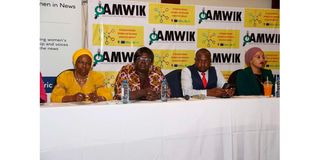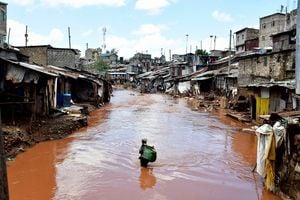Tell women's stories, veterans tell journalists as Amwik turns 40

From left: Daily Nation Editor Dorothy Kweyu, Women in news (Wan-Ifra) Africa Director Jane Godia, Media Council of Kenya CEO David Omwoyo and Chief Administrative Secretary in the Ministry of ICT, Innovation and Youth Affairs Nadia Abdallah, during the Association of Media Women in Kenya 40th anniversary celebrations at Crown Plaza Hotel in Nairobi on March 23, 2022.
What you need to know:
- Veteran women media executives have encouraged their fellow practicing journalists to fearlessly carry the baton forward.
- In 1982 when Amwik was founded, there were no female photographers.
- In 1985, the association started trainings that empowered women to participate in these public spaces.
Women in the media have celebrated the wins made in the past four decades even as they commit to increasing their representation in different roles in the newsrooms.
During the two-day celebrations to mark 40 years since Association of Media Women in Kenya (Amwik) was birthed, veteran women media executives encouraged their fellow practicing journalists to fearlessly carry the baton forward.
For instance, in 1982 when Amwik was founded, there were no female photographers. Today, a media house like Nation Media Group (NMG) has three female photographers.
Public spaces
“When AMWIK started there were very few women in media and governance. In 1985, we started conducting training programs and conferences that empowered women to participate in these public spaces,’’ said Sylvia Machini, former chairperson of Amwik board on March 23, the second day of the celebrations.
She challenged women never to tire of speaking for their rights, noting that it is the only way their capabilities can be rightfully recognised.
“We have to stand up and talk about ourselves, we have to talk about our stories because nobody is going to do it for us. We must participate in all spheres of society, whether economic, political, social or academic by speaking about ourselves and our achievements,” she emphasised.
Pamela Mburia who also served as Amwik’s board chairperson, exemplified the association’s role in raising the voices of women not only in the newsroom but also in news coverage.
She said the media association has aggressively trained journalists on gender-sensitive reporting, in the past 40 year, a skill that has improved the inclusion of women in news.
Female politicians
It has also trained female politicians on media engagement, enabling them to enhance their visibility in the media.
‘’A lot of women in parliament today went through that training. These include Rachel Shebesh, the first Nairobi County Woman Representative, Kandara MP Alice Wahome, and Suba North MP, Millie Odhiambo,’’ she said.
One woman who has stood the test of time is Pamella Sittoni, NMG Executive Editor, Partnerships.
She had a message for the women looking up to her: “There is nothing really difficult about rising into leadership in editorial. I am as ordinary as they come.”
“I had no privileges. I just worked hard,” explained Ms Sittoni while sharing her experience of how she rose from managing editor, The East African, to executive editor, Daily Nation, the leading newspaper in Kenya with a 75 per cent command in readership.
Meanwhile, Women in News Leadership Accelerator programme, an initiative of the World Association of Newspapers and News Publishers (Wan-Ifra), is empowering female journalists converting them into hotcakes undeniably impossible to ignore for promotions.
Wan-Ifra, Women in News Director for Africa Jane Godia, said the programme prepares the journalists to be impactful and effective media leaders.
“Women in News Leadership Accelerator programme is a unique offering …we help to build the capacity of women. Those who have gone through the programme will tell you within six months, their bosses see the difference in them.”






